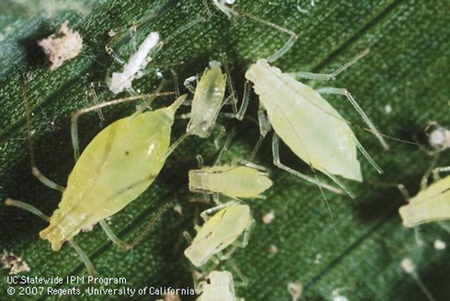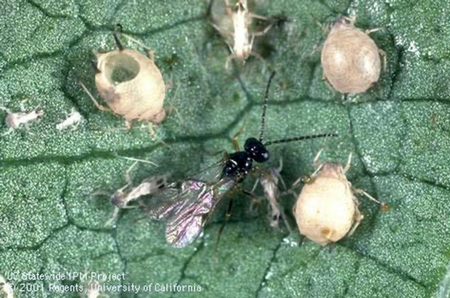Aphids can be a scourge in the garden. There are over 4,000 species of aphids in the world, but fortunately only(!) about 250 species are attracted to the plants we grow in our gardens and landscapes.
Aphids are small, slow-moving insects that come in a variety of colors—green, yellow, brown, red, or black. They sometimes match the color of the plant they feed on, but not always. They have long legs and antennae, and usually have a pair of cornicles (tube-like structures) sticking out of their hind end. No other insects have cornicles. Some adult aphids have wings—this can occur when populations are high or during spring and fall—that can allow them to disperse to other plants.
Aphid reproduction is interesting. Adult females can give birth to up to 12 live offspring each day without mating. During warm weather, many aphid species can grow from newborn nymph to reproductive adult in a week. No wonder it seems like they appear overnight.
Aphids are attracted to plants on which they can feed. Plants that are actively growing are prime targets. Right now, these include plants in our winter gardens such as kale and broccoli and landscape plants such as roses, but also the many winter weeds growing abundantly in many neighborhoods.
Aphids have sucking mouth parts, somewhat like little straws. They use them to suck sap (which is a plant's sugar source). What they excrete is commonly referred to as ‘honeydew' which contains sugar and is therefore sticky. Ants are attracted to this honeydew and will actively “farm” the aphids and protect them against natural predators.
Many plants, especially trees and shrubs, can survive just fine with low to moderate numbers of leaf-feeding aphids. Damage can occur with larger populations. Yellowing leaves and stunted growth are common.
Aphids can also transmit viruses from plant to plant on many vegetable crops and ornamental plants. Symptoms can include mottled, yellow, or curled leaves, along with stunted growth.
Controlling aphids
Understanding their life cycle is key to their management. By checking plants twice a week while they are growing rapidly, you can catch infestations early. With small populations of wingless aphids, hosing them off with a strong stream of water works well. Once off the plants, aphids are unlikely to be able to return. You can also prune out the most infested parts. Make sure you also remove nearby weeds that can serve as a reservoir of new infestations.
Natural enemies are important for aphid control. Parasitic wasps lay eggs inside live aphids, causing them to turn into mummies. You can recognize these by light-colored aphid bodies with circular holes on top where the wasp has emerged. Lady beetles (especially the larvae), syrphid fly larvae, and green lacewings are voracious eaters of aphids. See this website: https://ipm.ucanr.edu/natural-enemies/
If spraying with water is not effective enough, insecticidal soaps and oils are the best choices for most situations. Oils include petroleum-based horticultural oils or plant-derived oils such as neem or canola oil. These products kill primarily by smothering the aphid, so thorough coverage of infested foliage is required. Soaps and oils kill only those aphids present on the day they are sprayed, so applications may need to be repeated. Although these products can kill some natural enemies that are present on the plant and hit by the spray, they don't leave a toxic residue.
It is easier to manage aphids earlier in an infestation than later when populations are high. Some aphids cause leaves to curl around them, protecting them from sprays and beneficial insects.
Prevention
- When you purchase new plants, inspect them carefully.
- Don't over-fertilize. Excess fertilizers, especially too much nitrogen, can stimulate plants to put out lush new growth that will entice aphids to set up home.
- Excessive pruning can also stimulate plants to put out attractive new growth.
- Use a row cover, especially on seedlings and new plants. This will keep out aphids but also protect from other pests.
- Control ants that can protect aphids.
For more information, check these websites:
https://ipm.ucanr.edu/PMG/PESTNOTES/pn7404.html#TABLE1
https://ipm.ucanr.edu/QT/aphidscard.html
Attached Images:

